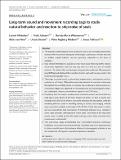Long-term sound and movement recording tags to study natural behavior and reaction to ship noise of seals
Abstract
1. The impact of anthropogenic noise on marine fauna is of increasing conservation concern with vessel noise being one of the major contributors. Animals that rely on shallow coastal habitats may be especially vulnerable to this form of pollution. 2. Very limited information is available on how much noise from ship traffic individual animals experience, and how they may react to it due to a lack of suitable methods. To address this, we developed long-duration audio and 3D-movement tags (DTAGs) and deployed them on three harbor seals and two gray seals in the North Sea during 2015-2016. 3. These tags recorded sound, accelerometry, magnetometry, and pressure continuously for up to 21 days. GPS positions were also sampled for one seal continuously throughout the recording period. A separate tag, combining a camera and an accelerometer logger, was deployed on two harbor seals to visualize specific behaviors that helped interpret accelerometer signals in the DTAG data. 4. Combining data from depth, accelerometer, and audio sensors, we found that animals spent 6.6%-42.3% of the time hauled out (either on land or partly submerged), and 5.3%-12.4% of their at-sea time resting at the sea bottom, while the remaining time was used for traveling, resting at surface, and foraging. Animals were exposed to audible vessel noise 2.2%-20.5% of their time when in water, and we demonstrate that interruption of functional behaviors (e.g., resting) in some cases coincides with high-level vessel noise. Two-thirds of the ship noise events were traceable by the AIS vessel tracking system, while one-third comprised vessels without AIS. 5. This preliminary study demonstrates how concomitant long-term continuous broadband on-animal sound and movement recordings may be an important tool in future quantification of disturbance effects of anthropogenic activities at sea and assessment of long-term population impacts on pinnipeds.
Citation
Mikkelsen , L , Johnson , M , Wisniewska , D M , van Neer , A , Siebert , U , Madsen , P T & Teilmann , J 2019 , ' Long-term sound and movement recording tags to study natural behavior and reaction to ship noise of seals ' , Ecology and Evolution , vol. Early View . https://doi.org/10.1002/ece3.4923
Publication
Ecology and Evolution
Status
Peer reviewed
ISSN
2045-7758Type
Journal article
Description
This study was funded by the German Federal Agency of Nature Conservation under the project “Effects of underwater noise on marine vertebrates” (Cluster 7, Z1.2‐53302/2010/14) and “Under Water Noise Effects – UWE” (Project numbers FKZ 3515822000). MJ was supported for development of the tags by a Marie Sklodowska‐Curie career integration grant and by the Marine Alliance for Science and Technology Scotland. PTM and DMW were partly supported by a large frame grant from the Danish National Research Council. DMW was also supported by an Office of Naval Research grant to Jeremy Goldbogen at Stanford University.Collections
Items in the St Andrews Research Repository are protected by copyright, with all rights reserved, unless otherwise indicated.

